LSBM100: Information Systems, ERP, and Organizational Control
VerifiedAdded on 2023/06/12
|9
|2721
|396
Essay
AI Summary
This essay provides a comprehensive analysis of information systems and Enterprise Resource Planning (ERP) systems, emphasizing their significance in managing and controlling information streams within organizations. It begins by classifying different types of information systems, including data processing systems, decision support systems, real-time systems, and knowledge-based systems, further detailing transaction processing systems, office automation systems, knowledge management systems, management information systems, decision support systems, and executive support systems. The essay then delves into ERP systems, highlighting their benefits in streamlining workflows, improving financial planning, and enhancing data accuracy, security, and accountability. It also addresses the challenges associated with ERP implementation, such as limited flexibility, data security vulnerabilities, high implementation costs, data migration complexities, and user adoption issues. The conclusion underscores the importance of aligning information systems with organizational functions and processes for competitive advantage, while also acknowledging the need to carefully plan and address the challenges associated with ERP systems to ensure effective implementation and maintenance. The essay finally suggests the inclusion of AI within information systems for better communication.
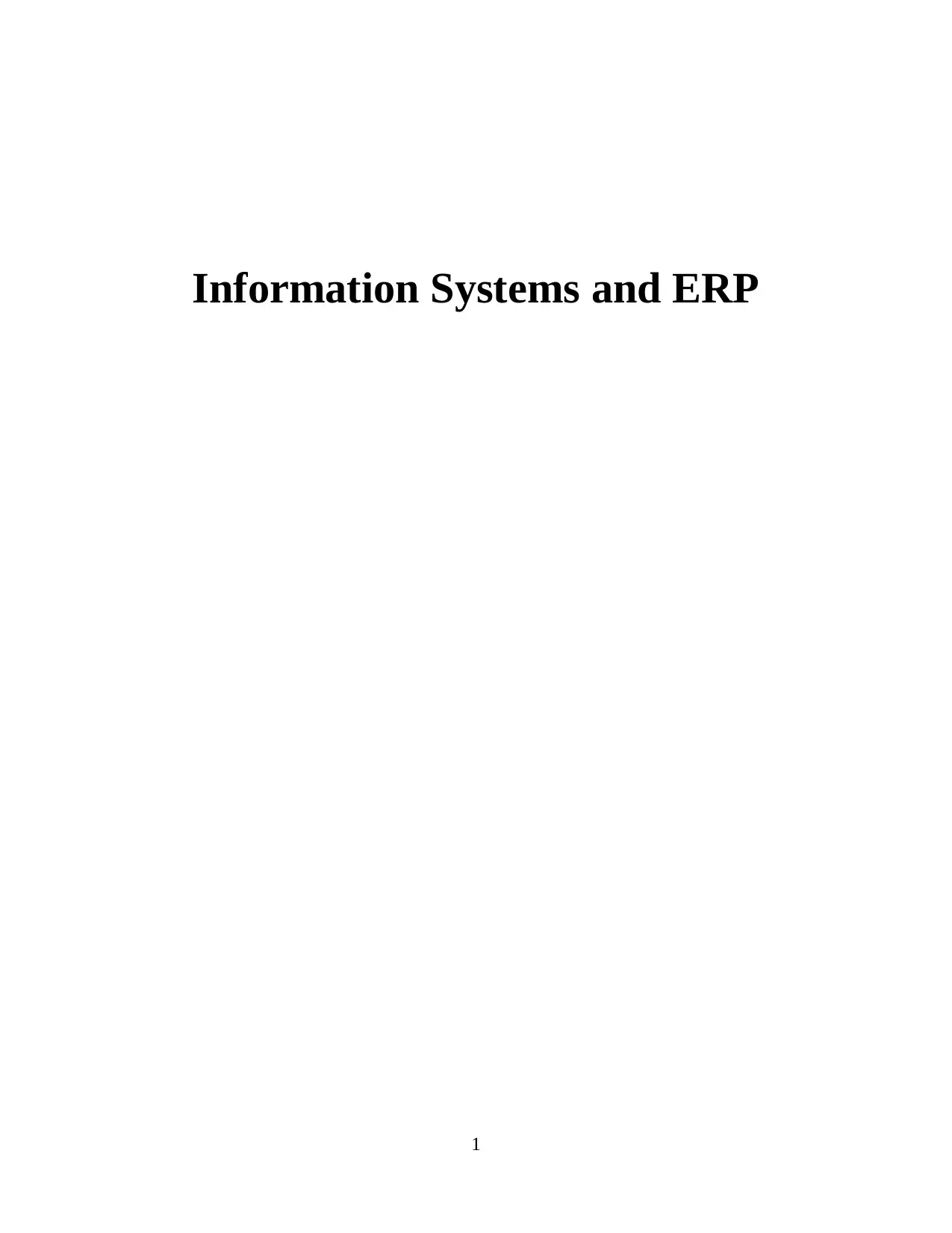
Information Systems and ERP
1
1
Paraphrase This Document
Need a fresh take? Get an instant paraphrase of this document with our AI Paraphraser
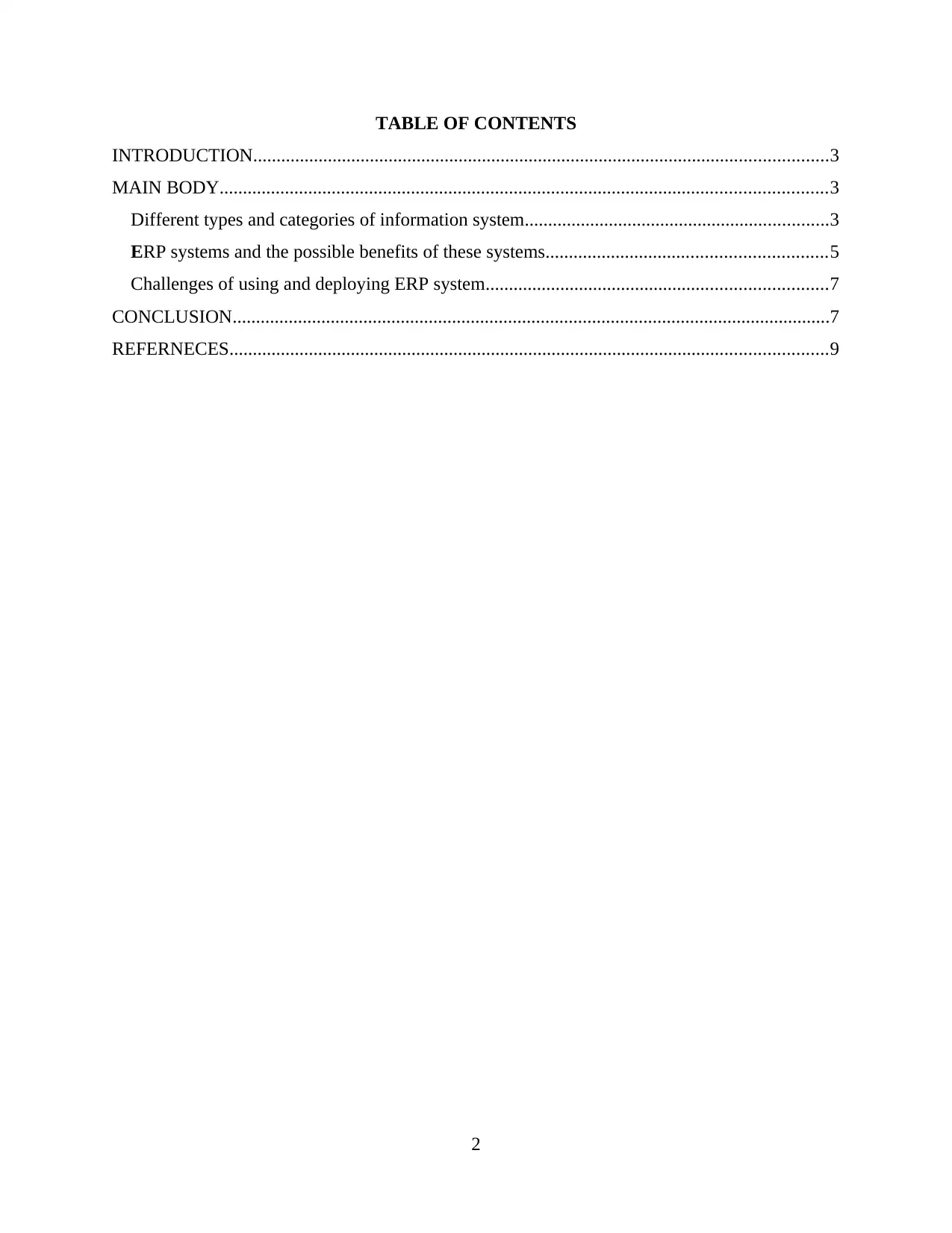
TABLE OF CONTENTS
INTRODUCTION...........................................................................................................................3
MAIN BODY..................................................................................................................................3
Different types and categories of information system.................................................................3
ERP systems and the possible benefits of these systems............................................................5
Challenges of using and deploying ERP system.........................................................................7
CONCLUSION................................................................................................................................7
REFERNECES................................................................................................................................9
2
INTRODUCTION...........................................................................................................................3
MAIN BODY..................................................................................................................................3
Different types and categories of information system.................................................................3
ERP systems and the possible benefits of these systems............................................................5
Challenges of using and deploying ERP system.........................................................................7
CONCLUSION................................................................................................................................7
REFERNECES................................................................................................................................9
2
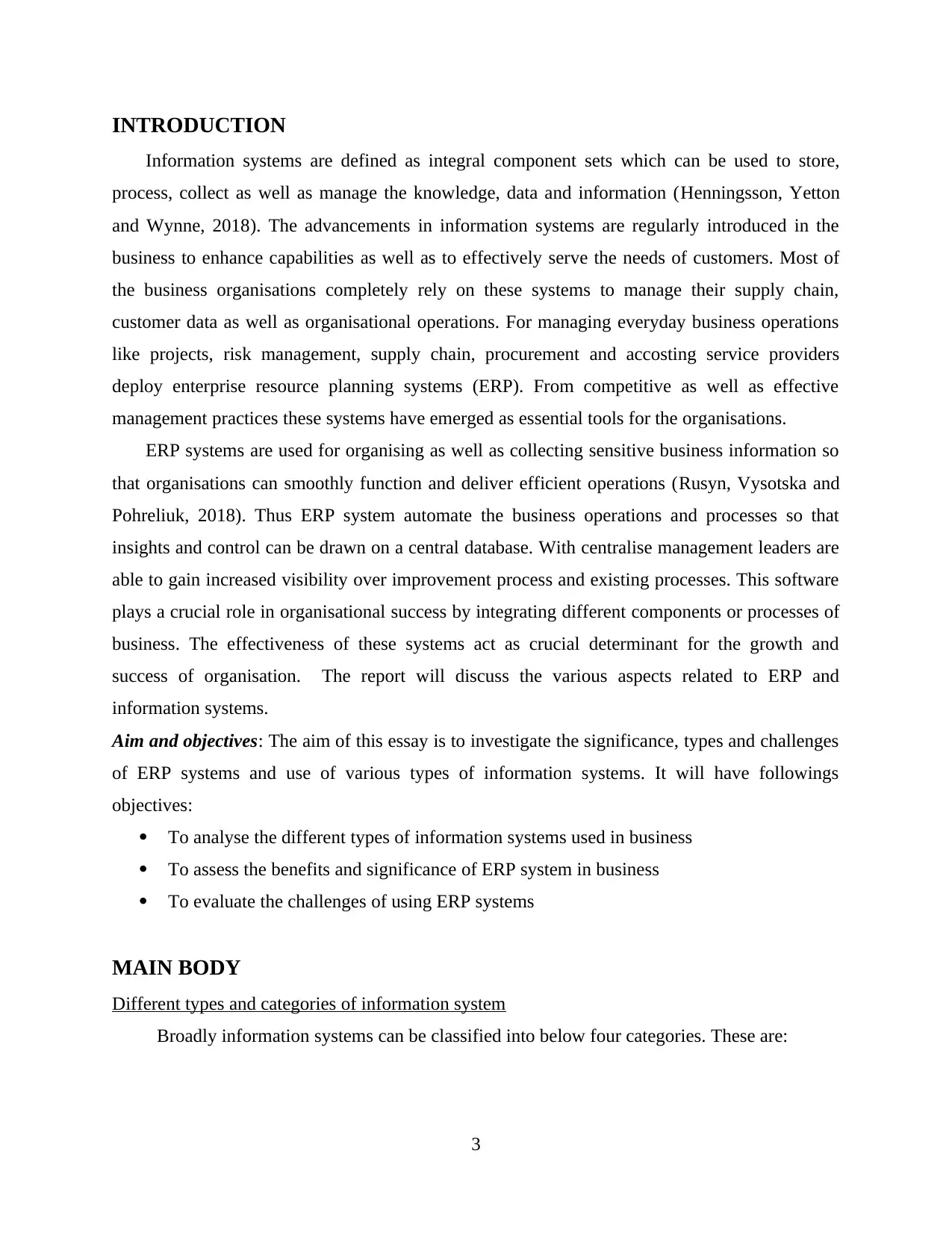
INTRODUCTION
Information systems are defined as integral component sets which can be used to store,
process, collect as well as manage the knowledge, data and information (Henningsson, Yetton
and Wynne, 2018). The advancements in information systems are regularly introduced in the
business to enhance capabilities as well as to effectively serve the needs of customers. Most of
the business organisations completely rely on these systems to manage their supply chain,
customer data as well as organisational operations. For managing everyday business operations
like projects, risk management, supply chain, procurement and accosting service providers
deploy enterprise resource planning systems (ERP). From competitive as well as effective
management practices these systems have emerged as essential tools for the organisations.
ERP systems are used for organising as well as collecting sensitive business information so
that organisations can smoothly function and deliver efficient operations (Rusyn, Vysotska and
Pohreliuk, 2018). Thus ERP system automate the business operations and processes so that
insights and control can be drawn on a central database. With centralise management leaders are
able to gain increased visibility over improvement process and existing processes. This software
plays a crucial role in organisational success by integrating different components or processes of
business. The effectiveness of these systems act as crucial determinant for the growth and
success of organisation. The report will discuss the various aspects related to ERP and
information systems.
Aim and objectives: The aim of this essay is to investigate the significance, types and challenges
of ERP systems and use of various types of information systems. It will have followings
objectives:
To analyse the different types of information systems used in business
To assess the benefits and significance of ERP system in business
To evaluate the challenges of using ERP systems
MAIN BODY
Different types and categories of information system
Broadly information systems can be classified into below four categories. These are:
3
Information systems are defined as integral component sets which can be used to store,
process, collect as well as manage the knowledge, data and information (Henningsson, Yetton
and Wynne, 2018). The advancements in information systems are regularly introduced in the
business to enhance capabilities as well as to effectively serve the needs of customers. Most of
the business organisations completely rely on these systems to manage their supply chain,
customer data as well as organisational operations. For managing everyday business operations
like projects, risk management, supply chain, procurement and accosting service providers
deploy enterprise resource planning systems (ERP). From competitive as well as effective
management practices these systems have emerged as essential tools for the organisations.
ERP systems are used for organising as well as collecting sensitive business information so
that organisations can smoothly function and deliver efficient operations (Rusyn, Vysotska and
Pohreliuk, 2018). Thus ERP system automate the business operations and processes so that
insights and control can be drawn on a central database. With centralise management leaders are
able to gain increased visibility over improvement process and existing processes. This software
plays a crucial role in organisational success by integrating different components or processes of
business. The effectiveness of these systems act as crucial determinant for the growth and
success of organisation. The report will discuss the various aspects related to ERP and
information systems.
Aim and objectives: The aim of this essay is to investigate the significance, types and challenges
of ERP systems and use of various types of information systems. It will have followings
objectives:
To analyse the different types of information systems used in business
To assess the benefits and significance of ERP system in business
To evaluate the challenges of using ERP systems
MAIN BODY
Different types and categories of information system
Broadly information systems can be classified into below four categories. These are:
3
⊘ This is a preview!⊘
Do you want full access?
Subscribe today to unlock all pages.

Trusted by 1+ million students worldwide

Data processing system: These IS having huge information database so that data can be quickly
accessed and processed (Xie and et.al., 2019). Transaction processing system or MIS are its
common examples in which data is stored and users are allowed to easily process and access it.
Decision support system: Data processing based systems are capable enough to diagnose and
identify problems but they are not able to recommend appropriate solution. Thus with decision
support systems problem related data is modelled into specific model so that suitable solution
can be suggested. For this purpose, decision support system often includes statistical models and
operational research concepts. The selection of model depends upon leaders and managers thus
the problem solving depends upon managers only. The purpose of such type of information
systems is to simplify the problems and to suggest appropriate remedies for the issue.
Real time system: Since external business environment is not controlled by system thus system
has to responds to data. Real time systems provide quick response to external environment
changes (Alsharari, 2020). Thus they are robust to failures and errors and are able to respond in
controlled manner. In real time systems fast response is often achieved by the task prioritisation
which are communicated and applied without any interference.
Knowledge based system: In addition to data handling knowledge management is also a crucial
part of business operations. Similar to database these systems encapsulate vast knowledge so that
problems can be easily solved in business. Knowledge based systems are also called expert
systems in which specific business related problems are answered or solved by the existing
policies, procedures and work standards. It is important to keep and integrate these systems in
alignment with the advanced changing procedures and needs of business environment so that
robust and accurate solutions can be provided for given problems using knowledge capsules
(Vadivelu and et.al., 2018).
Businesses mainly uses 6 types of information systems so that their functionality can help
in effective management. These systems are:
Transaction processing system: It consist of business transaction activities and
information related to sales and purchases of organisation. It includes data related to client
customer management, bank deposits or inventory count (Henningsson, Yetton and Wynne,
2018). System ensure the safe, reliable and accessible management of al contractual, customer
relation and transactional data
4
accessed and processed (Xie and et.al., 2019). Transaction processing system or MIS are its
common examples in which data is stored and users are allowed to easily process and access it.
Decision support system: Data processing based systems are capable enough to diagnose and
identify problems but they are not able to recommend appropriate solution. Thus with decision
support systems problem related data is modelled into specific model so that suitable solution
can be suggested. For this purpose, decision support system often includes statistical models and
operational research concepts. The selection of model depends upon leaders and managers thus
the problem solving depends upon managers only. The purpose of such type of information
systems is to simplify the problems and to suggest appropriate remedies for the issue.
Real time system: Since external business environment is not controlled by system thus system
has to responds to data. Real time systems provide quick response to external environment
changes (Alsharari, 2020). Thus they are robust to failures and errors and are able to respond in
controlled manner. In real time systems fast response is often achieved by the task prioritisation
which are communicated and applied without any interference.
Knowledge based system: In addition to data handling knowledge management is also a crucial
part of business operations. Similar to database these systems encapsulate vast knowledge so that
problems can be easily solved in business. Knowledge based systems are also called expert
systems in which specific business related problems are answered or solved by the existing
policies, procedures and work standards. It is important to keep and integrate these systems in
alignment with the advanced changing procedures and needs of business environment so that
robust and accurate solutions can be provided for given problems using knowledge capsules
(Vadivelu and et.al., 2018).
Businesses mainly uses 6 types of information systems so that their functionality can help
in effective management. These systems are:
Transaction processing system: It consist of business transaction activities and
information related to sales and purchases of organisation. It includes data related to client
customer management, bank deposits or inventory count (Henningsson, Yetton and Wynne,
2018). System ensure the safe, reliable and accessible management of al contractual, customer
relation and transactional data
4
Paraphrase This Document
Need a fresh take? Get an instant paraphrase of this document with our AI Paraphraser
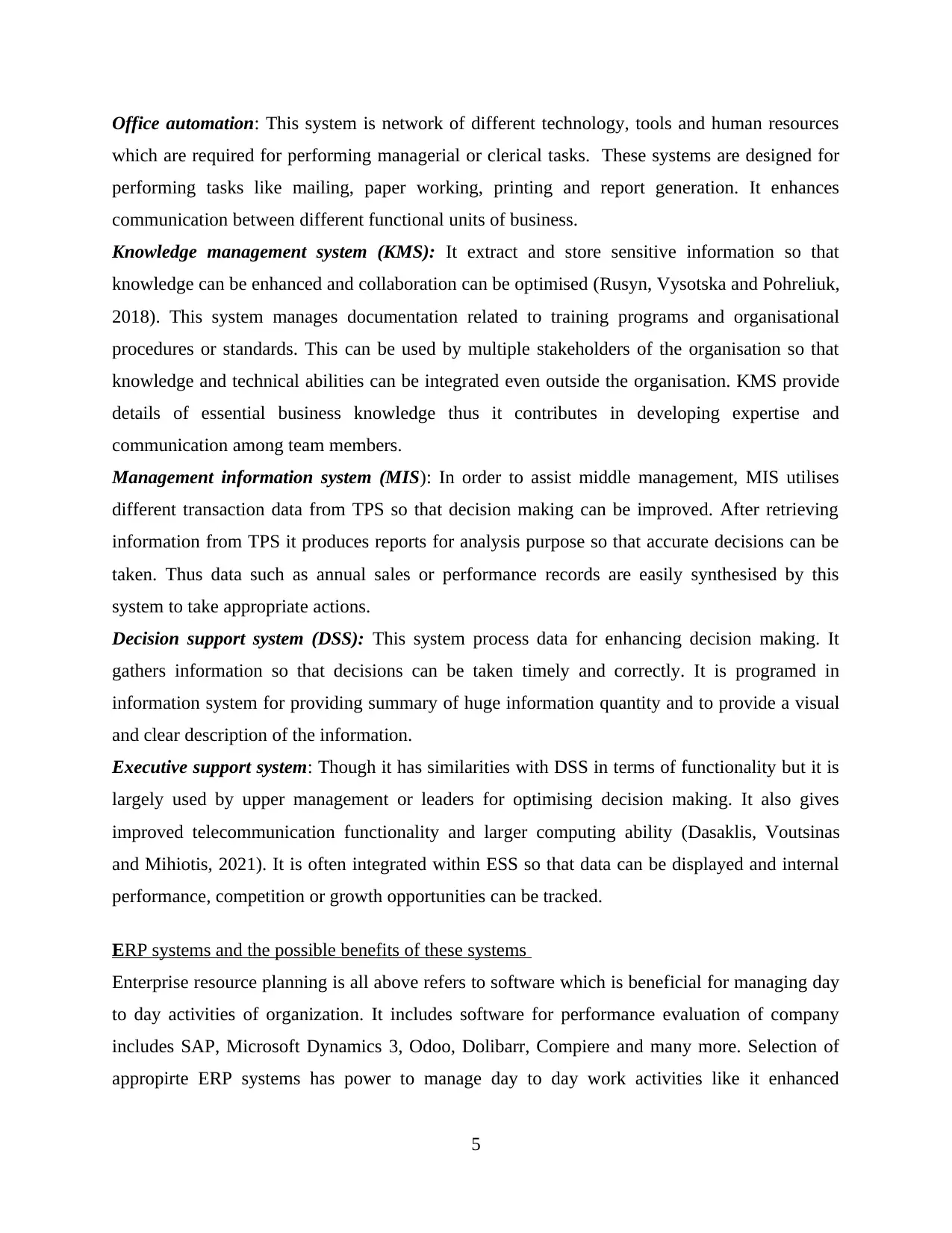
Office automation: This system is network of different technology, tools and human resources
which are required for performing managerial or clerical tasks. These systems are designed for
performing tasks like mailing, paper working, printing and report generation. It enhances
communication between different functional units of business.
Knowledge management system (KMS): It extract and store sensitive information so that
knowledge can be enhanced and collaboration can be optimised (Rusyn, Vysotska and Pohreliuk,
2018). This system manages documentation related to training programs and organisational
procedures or standards. This can be used by multiple stakeholders of the organisation so that
knowledge and technical abilities can be integrated even outside the organisation. KMS provide
details of essential business knowledge thus it contributes in developing expertise and
communication among team members.
Management information system (MIS): In order to assist middle management, MIS utilises
different transaction data from TPS so that decision making can be improved. After retrieving
information from TPS it produces reports for analysis purpose so that accurate decisions can be
taken. Thus data such as annual sales or performance records are easily synthesised by this
system to take appropriate actions.
Decision support system (DSS): This system process data for enhancing decision making. It
gathers information so that decisions can be taken timely and correctly. It is programed in
information system for providing summary of huge information quantity and to provide a visual
and clear description of the information.
Executive support system: Though it has similarities with DSS in terms of functionality but it is
largely used by upper management or leaders for optimising decision making. It also gives
improved telecommunication functionality and larger computing ability (Dasaklis, Voutsinas
and Mihiotis, 2021). It is often integrated within ESS so that data can be displayed and internal
performance, competition or growth opportunities can be tracked.
ERP systems and the possible benefits of these systems
Enterprise resource planning is all above refers to software which is beneficial for managing day
to day activities of organization. It includes software for performance evaluation of company
includes SAP, Microsoft Dynamics 3, Odoo, Dolibarr, Compiere and many more. Selection of
appropirte ERP systems has power to manage day to day work activities like it enhanced
5
which are required for performing managerial or clerical tasks. These systems are designed for
performing tasks like mailing, paper working, printing and report generation. It enhances
communication between different functional units of business.
Knowledge management system (KMS): It extract and store sensitive information so that
knowledge can be enhanced and collaboration can be optimised (Rusyn, Vysotska and Pohreliuk,
2018). This system manages documentation related to training programs and organisational
procedures or standards. This can be used by multiple stakeholders of the organisation so that
knowledge and technical abilities can be integrated even outside the organisation. KMS provide
details of essential business knowledge thus it contributes in developing expertise and
communication among team members.
Management information system (MIS): In order to assist middle management, MIS utilises
different transaction data from TPS so that decision making can be improved. After retrieving
information from TPS it produces reports for analysis purpose so that accurate decisions can be
taken. Thus data such as annual sales or performance records are easily synthesised by this
system to take appropriate actions.
Decision support system (DSS): This system process data for enhancing decision making. It
gathers information so that decisions can be taken timely and correctly. It is programed in
information system for providing summary of huge information quantity and to provide a visual
and clear description of the information.
Executive support system: Though it has similarities with DSS in terms of functionality but it is
largely used by upper management or leaders for optimising decision making. It also gives
improved telecommunication functionality and larger computing ability (Dasaklis, Voutsinas
and Mihiotis, 2021). It is often integrated within ESS so that data can be displayed and internal
performance, competition or growth opportunities can be tracked.
ERP systems and the possible benefits of these systems
Enterprise resource planning is all above refers to software which is beneficial for managing day
to day activities of organization. It includes software for performance evaluation of company
includes SAP, Microsoft Dynamics 3, Odoo, Dolibarr, Compiere and many more. Selection of
appropirte ERP systems has power to manage day to day work activities like it enhanced
5

business reporting in specific time because idea and information of sales has power to develop
efficiency within business practices (Shukor and et.al., 2020). Company manager can easily
evaluates and understand which major factors are challenging aspects of business and which is
major beneficial activities makes more sustainability in sales. SAP software’s is one of the most
beneficial tools which provide clear ideas in terms of enable customers to run their business
process, including accounting, sales, production activity, integrate environment and many more.
ERP system streamlines workflows, better financial planning, improve data accuracy, security
and accountability with great manner. One major thing which individual company has to
recognize before involvement of ERP software is it requires expert’s knowledge and technology
management experts for managing software’s (Bjelland and Haddara, 2018). Effective
knowledge of ERP software’s and tools benefits are as follows,
Improve inventory planning: Inventory system includes logistics, operations, finance,
inventory and many more which helps to improving sustainability within process of financial
management activities. It helps to gives knowledge for product quality, consistency, services,
customer attraction and many more which provides good ideas to operational manager so they
can develop new plans, strategies and projects on the basis of requirement identification. Proper
ideas of raw material involvement reduce wastages which is very effective term for financial
sustainability. So from the information this term its very clear that having appropriate methods
and process has power to build higher effectiveness improve inventory planning which helpful
for the operational management team or manager so they can easily engage appropriate resources
and manufacturing process.
Accuracy in forecasting: Forecasting in term of sales, profit, revenue generate chances gives
ideas and information for managing goods and services with appropriate manner. Having
sustainable tools utilization within forecasting evaluation can be easily possible when company
engage technology utilization and application experts because they do have power to evaluate
performance of product before employee complete overall takes (Costa, Aparicio and Raposo,
2020). So from the forecasting process its easier term to determine how much investment
company has top expand on specific product manufacturing which is very useful for reduce
unnecessary manufacturing process.
Faster method of financial close: And the last one is faster methods of financial close which
means when company ERP system clearly shows selling and customer attraction towards with
6
efficiency within business practices (Shukor and et.al., 2020). Company manager can easily
evaluates and understand which major factors are challenging aspects of business and which is
major beneficial activities makes more sustainability in sales. SAP software’s is one of the most
beneficial tools which provide clear ideas in terms of enable customers to run their business
process, including accounting, sales, production activity, integrate environment and many more.
ERP system streamlines workflows, better financial planning, improve data accuracy, security
and accountability with great manner. One major thing which individual company has to
recognize before involvement of ERP software is it requires expert’s knowledge and technology
management experts for managing software’s (Bjelland and Haddara, 2018). Effective
knowledge of ERP software’s and tools benefits are as follows,
Improve inventory planning: Inventory system includes logistics, operations, finance,
inventory and many more which helps to improving sustainability within process of financial
management activities. It helps to gives knowledge for product quality, consistency, services,
customer attraction and many more which provides good ideas to operational manager so they
can develop new plans, strategies and projects on the basis of requirement identification. Proper
ideas of raw material involvement reduce wastages which is very effective term for financial
sustainability. So from the information this term its very clear that having appropriate methods
and process has power to build higher effectiveness improve inventory planning which helpful
for the operational management team or manager so they can easily engage appropriate resources
and manufacturing process.
Accuracy in forecasting: Forecasting in term of sales, profit, revenue generate chances gives
ideas and information for managing goods and services with appropriate manner. Having
sustainable tools utilization within forecasting evaluation can be easily possible when company
engage technology utilization and application experts because they do have power to evaluate
performance of product before employee complete overall takes (Costa, Aparicio and Raposo,
2020). So from the forecasting process its easier term to determine how much investment
company has top expand on specific product manufacturing which is very useful for reduce
unnecessary manufacturing process.
Faster method of financial close: And the last one is faster methods of financial close which
means when company ERP system clearly shows selling and customer attraction towards with
6
⊘ This is a preview!⊘
Do you want full access?
Subscribe today to unlock all pages.

Trusted by 1+ million students worldwide

business products and services its very useful approach for develop higher effectiveness in
evaluation of product cost identification. Financial close is mainly refers to determines wisely
invests in growth of products and services with great manner. Forecast helps to identify that
which resources essential to involves within business practice and how it makes higher
efficiency in business consistency. Clear and perfect idea and information of product
requirement beneficial for manufacturing process and financial manager can also manage their
financial activities and identify which things they do have to add on within business practices for
more growth opportunity expansion.
Challenges of using and deploying ERP system
Despite several benefits ERP systems faces various challenges among which first one if
flexibility. The limited flexibility of system can have negative impact on overall growth of the
firm. Most of the ERP systems are managed by cloud and thus sensitive data has vulnerability of
third party control risk. The existing security measure of password are not enough and are highly
at risk of phishing and other data security threats (Muslmani and et.al., 2018). Though ERP
system provide low IT cost but their implementation and maintenance is very high. If they
include customisation, then this can add on to more charges. The most prominent ERP challenge
is data migration. Data migration can be a tough task as it also includes high security challenges
during and after data migration. For the businesses which are planning to shift to ERP planning
the processes to integrate with ERP is itself a greater challenge. They also struggle to select
suitable type of ERP so that it can meet business needs with desired cost. Another popular
challenge which result in ERP failure is mind shift issues. While implementing ERP systems
their platform and user experience can impose a challenge for the service users (Chang, 2020).
This can create performance issues in the outcomes which are hard to align and balance.
CONCLUSION
It can be concluded from the above study that for gaining competitive advantage and
effective functioning of the firm information systems must be suitably aligned with the
organisational functions and processes. These systems are important in providing competitive
advantage as they organise organisational information in most effective and competitive way. It
7
evaluation of product cost identification. Financial close is mainly refers to determines wisely
invests in growth of products and services with great manner. Forecast helps to identify that
which resources essential to involves within business practice and how it makes higher
efficiency in business consistency. Clear and perfect idea and information of product
requirement beneficial for manufacturing process and financial manager can also manage their
financial activities and identify which things they do have to add on within business practices for
more growth opportunity expansion.
Challenges of using and deploying ERP system
Despite several benefits ERP systems faces various challenges among which first one if
flexibility. The limited flexibility of system can have negative impact on overall growth of the
firm. Most of the ERP systems are managed by cloud and thus sensitive data has vulnerability of
third party control risk. The existing security measure of password are not enough and are highly
at risk of phishing and other data security threats (Muslmani and et.al., 2018). Though ERP
system provide low IT cost but their implementation and maintenance is very high. If they
include customisation, then this can add on to more charges. The most prominent ERP challenge
is data migration. Data migration can be a tough task as it also includes high security challenges
during and after data migration. For the businesses which are planning to shift to ERP planning
the processes to integrate with ERP is itself a greater challenge. They also struggle to select
suitable type of ERP so that it can meet business needs with desired cost. Another popular
challenge which result in ERP failure is mind shift issues. While implementing ERP systems
their platform and user experience can impose a challenge for the service users (Chang, 2020).
This can create performance issues in the outcomes which are hard to align and balance.
CONCLUSION
It can be concluded from the above study that for gaining competitive advantage and
effective functioning of the firm information systems must be suitably aligned with the
organisational functions and processes. These systems are important in providing competitive
advantage as they organise organisational information in most effective and competitive way. It
7
Paraphrase This Document
Need a fresh take? Get an instant paraphrase of this document with our AI Paraphraser

has been also analysed that ERP systems have become an important part of the organisational
processes and resource management. However, their benefits must not cover the challenges
related to their disadvantages. Thus with the implementation of ERP systems organisations must
also focus upon the associated challenges of data migration and privacy threats. ERP
implementation cost may vary greatly depending upon cloud service provider and the customised
needs of businesses. Hence it is required that implementation and maintenance must be planned
carefully.
It has been also analysed that organisational growth comes with greater responsibility,
challenges and need for strong communication or strategic planning. With expansion needs it
becomes mandatory for the firms to include artificial intelligence within information systems so
that communication, collaboration and transaction speed can be increased to grate extent.
Business environment is dynamic in nature and thus the related data has wider range and scope.
It also demands for the improved intelligence system so that each functional unit of business can
organise data in a way to meet business objectives.
It has been also analysed that implementation of ERP system in businesses result in vast
number of benefits in terms of optimise utilisation of resources and data. The system helps in
managing data in competitive way so that decision making and business productivity can be
increased. Thus organisations must emphasis on choosing ERP system which can drive their
productivity for several years.
8
processes and resource management. However, their benefits must not cover the challenges
related to their disadvantages. Thus with the implementation of ERP systems organisations must
also focus upon the associated challenges of data migration and privacy threats. ERP
implementation cost may vary greatly depending upon cloud service provider and the customised
needs of businesses. Hence it is required that implementation and maintenance must be planned
carefully.
It has been also analysed that organisational growth comes with greater responsibility,
challenges and need for strong communication or strategic planning. With expansion needs it
becomes mandatory for the firms to include artificial intelligence within information systems so
that communication, collaboration and transaction speed can be increased to grate extent.
Business environment is dynamic in nature and thus the related data has wider range and scope.
It also demands for the improved intelligence system so that each functional unit of business can
organise data in a way to meet business objectives.
It has been also analysed that implementation of ERP system in businesses result in vast
number of benefits in terms of optimise utilisation of resources and data. The system helps in
managing data in competitive way so that decision making and business productivity can be
increased. Thus organisations must emphasis on choosing ERP system which can drive their
productivity for several years.
8
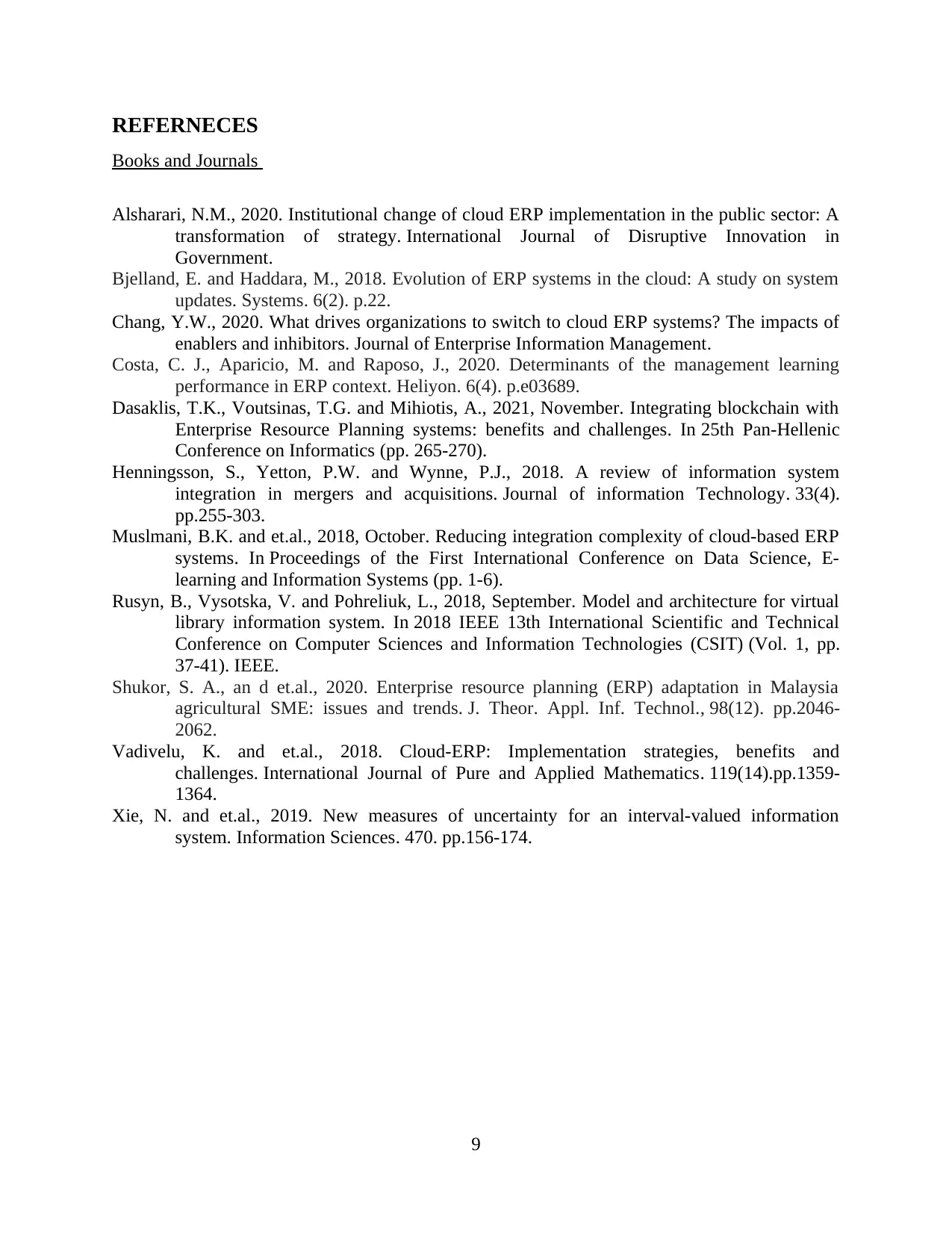
REFERNECES
Books and Journals
Alsharari, N.M., 2020. Institutional change of cloud ERP implementation in the public sector: A
transformation of strategy. International Journal of Disruptive Innovation in
Government.
Bjelland, E. and Haddara, M., 2018. Evolution of ERP systems in the cloud: A study on system
updates. Systems. 6(2). p.22.
Chang, Y.W., 2020. What drives organizations to switch to cloud ERP systems? The impacts of
enablers and inhibitors. Journal of Enterprise Information Management.
Costa, C. J., Aparicio, M. and Raposo, J., 2020. Determinants of the management learning
performance in ERP context. Heliyon. 6(4). p.e03689.
Dasaklis, T.K., Voutsinas, T.G. and Mihiotis, A., 2021, November. Integrating blockchain with
Enterprise Resource Planning systems: benefits and challenges. In 25th Pan-Hellenic
Conference on Informatics (pp. 265-270).
Henningsson, S., Yetton, P.W. and Wynne, P.J., 2018. A review of information system
integration in mergers and acquisitions. Journal of information Technology. 33(4).
pp.255-303.
Muslmani, B.K. and et.al., 2018, October. Reducing integration complexity of cloud-based ERP
systems. In Proceedings of the First International Conference on Data Science, E-
learning and Information Systems (pp. 1-6).
Rusyn, B., Vysotska, V. and Pohreliuk, L., 2018, September. Model and architecture for virtual
library information system. In 2018 IEEE 13th International Scientific and Technical
Conference on Computer Sciences and Information Technologies (CSIT) (Vol. 1, pp.
37-41). IEEE.
Shukor, S. A., an d et.al., 2020. Enterprise resource planning (ERP) adaptation in Malaysia
agricultural SME: issues and trends. J. Theor. Appl. Inf. Technol., 98(12). pp.2046-
2062.
Vadivelu, K. and et.al., 2018. Cloud-ERP: Implementation strategies, benefits and
challenges. International Journal of Pure and Applied Mathematics. 119(14).pp.1359-
1364.
Xie, N. and et.al., 2019. New measures of uncertainty for an interval-valued information
system. Information Sciences. 470. pp.156-174.
9
Books and Journals
Alsharari, N.M., 2020. Institutional change of cloud ERP implementation in the public sector: A
transformation of strategy. International Journal of Disruptive Innovation in
Government.
Bjelland, E. and Haddara, M., 2018. Evolution of ERP systems in the cloud: A study on system
updates. Systems. 6(2). p.22.
Chang, Y.W., 2020. What drives organizations to switch to cloud ERP systems? The impacts of
enablers and inhibitors. Journal of Enterprise Information Management.
Costa, C. J., Aparicio, M. and Raposo, J., 2020. Determinants of the management learning
performance in ERP context. Heliyon. 6(4). p.e03689.
Dasaklis, T.K., Voutsinas, T.G. and Mihiotis, A., 2021, November. Integrating blockchain with
Enterprise Resource Planning systems: benefits and challenges. In 25th Pan-Hellenic
Conference on Informatics (pp. 265-270).
Henningsson, S., Yetton, P.W. and Wynne, P.J., 2018. A review of information system
integration in mergers and acquisitions. Journal of information Technology. 33(4).
pp.255-303.
Muslmani, B.K. and et.al., 2018, October. Reducing integration complexity of cloud-based ERP
systems. In Proceedings of the First International Conference on Data Science, E-
learning and Information Systems (pp. 1-6).
Rusyn, B., Vysotska, V. and Pohreliuk, L., 2018, September. Model and architecture for virtual
library information system. In 2018 IEEE 13th International Scientific and Technical
Conference on Computer Sciences and Information Technologies (CSIT) (Vol. 1, pp.
37-41). IEEE.
Shukor, S. A., an d et.al., 2020. Enterprise resource planning (ERP) adaptation in Malaysia
agricultural SME: issues and trends. J. Theor. Appl. Inf. Technol., 98(12). pp.2046-
2062.
Vadivelu, K. and et.al., 2018. Cloud-ERP: Implementation strategies, benefits and
challenges. International Journal of Pure and Applied Mathematics. 119(14).pp.1359-
1364.
Xie, N. and et.al., 2019. New measures of uncertainty for an interval-valued information
system. Information Sciences. 470. pp.156-174.
9
⊘ This is a preview!⊘
Do you want full access?
Subscribe today to unlock all pages.

Trusted by 1+ million students worldwide
1 out of 9
Related Documents
Your All-in-One AI-Powered Toolkit for Academic Success.
+13062052269
info@desklib.com
Available 24*7 on WhatsApp / Email
![[object Object]](/_next/static/media/star-bottom.7253800d.svg)
Unlock your academic potential
Copyright © 2020–2025 A2Z Services. All Rights Reserved. Developed and managed by ZUCOL.




